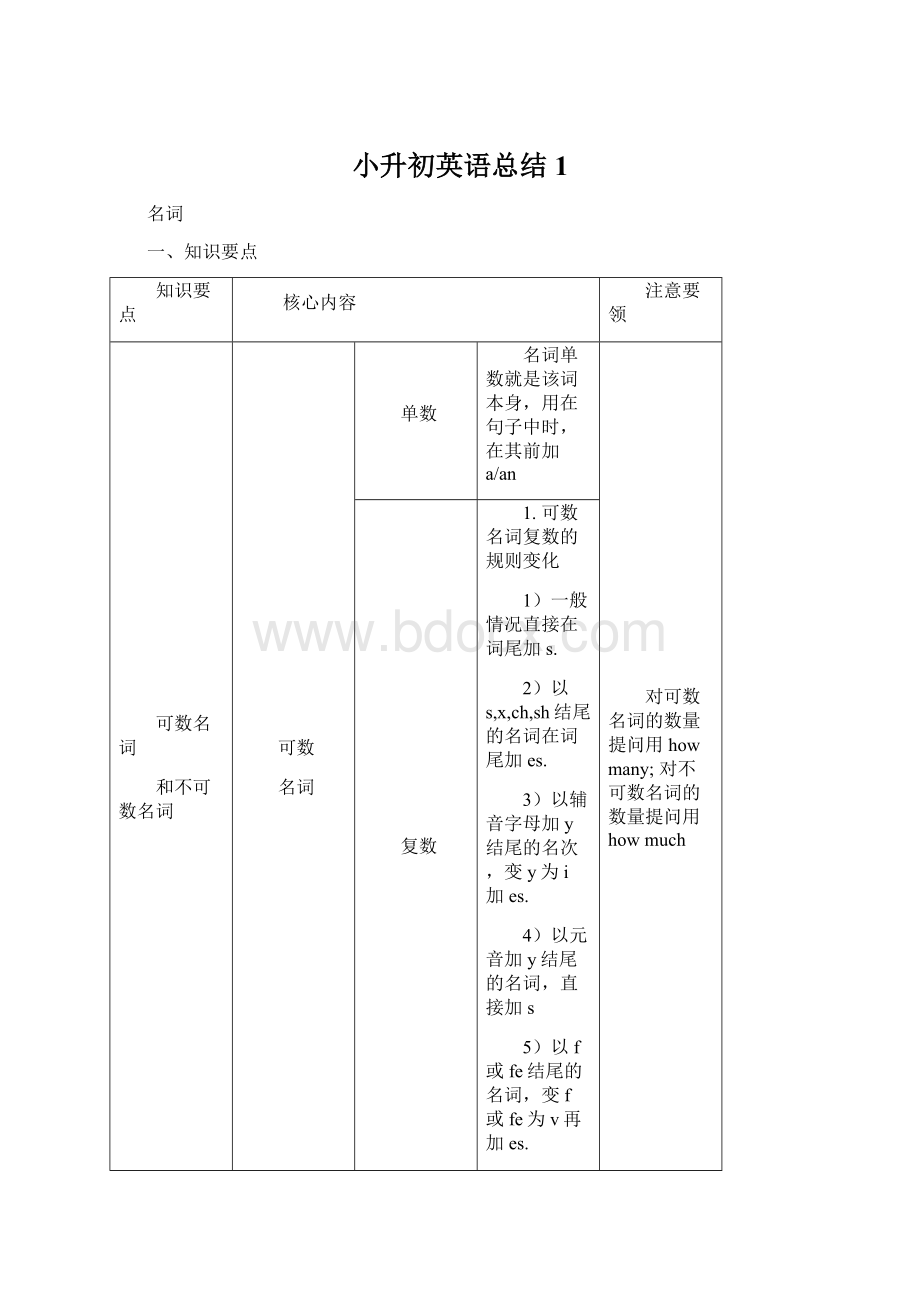小升初英语总结1.docx
《小升初英语总结1.docx》由会员分享,可在线阅读,更多相关《小升初英语总结1.docx(55页珍藏版)》请在冰豆网上搜索。

小升初英语总结1
名词
一、知识要点
知识要点
核心内容
注意要领
可数名词
和不可数名词
可数
名词
单数
名词单数就是该词本身,用在句子中时,在其前加a/an
对可数名词的数量提问用howmany;对不可数名词的数量提问用howmuch
复数
1.可数名词复数的规则变化
1)一般情况直接在词尾加s.
2)以s,x,ch,sh结尾的名词在词尾加es.
3)以辅音字母加y结尾的名次,变y为i加es.
4)以元音加y结尾的名词,直接加s
5)以f或fe结尾的名词,变f或fe为v再加es.
6)以o结尾的名词,加s(个别加es)
2.可数名词不规则的变化
1)单复数同行
Sheep-sheep,fish-fish,deer-deer,people-people,English-English,Chinese-Chinese
2)改变单词中的元音字母
Man-men,woman-women,foot-feet,tooth-teeth,goose-geese
3)词尾加en或ren
Child-children
4)特殊变化mouse-mice
3.复合名词前面的词是man,woman,
1)变复数时,构成复合名词的两个名词都要变成复数形式;如是其他词,变复数,只变后面的名词
manteacher-menteachers
Boystudent-boystudents
2)man,woman构成的合成名词,则只需把man,woamn变成复数
Policeman-policemen
Postman-postwomen
不可数名词
不可数名词的量有以下两种表示方法:
1.可用much,alotof,alittle,little,lotsof,plentyof,some等表示不可数名词的量
2.可用量词表示不可数名词的量
数词+量词+of+不可数名词
Acupoftea-twocupsoftea
Aglassofwater-twoglassesofwater
名词所有格
名词+’s
构成方法:
1.一般在名词后加’s
Jim’scomputer
2.以s结尾的复数名词,只加’
teachers’books
3.词尾不是以s结尾的复数名词,加‘s
children’sbooks
4.几个人共同拥有某物时,在最后一个人名后加’s
LilyandLucy’sroom
5.每个人分别拥有某物时,在每个人名后各加’s
Lily’sandLucy’srooms
6.名词所有格加在人名或职位后面时,可以表示某人的家或店铺。
TheWhite’s
7.有些指时间或距离的短语,也可以用’s构成所有格
10minutes’walk
由of短语构成的所有格
1.无生命的名词一般用of短语构成名词所有格,表示所有关系
Thenameoftheboy
Thedooroftheroom
2.双重所有格
活学活用
1.写出下列单词的复数形式
1)Bag_____Baby______Woman______
2)Knife_____People______Tomato______
3)Mouse_____Box______Child______
4)Sheep______Boy______year______
2.单项选择
()1.I’mthirsty.Iwanttobuysome______.
A.watersB.waterC.bread
()2.I’dlike_____ofapplejuice.
A.glassB.twoglassC.aglass
()3.Howmany_____arethereinyourschool?
A.studentB.studentsC.studentes
()4.Myfatherhas_____forbreakfast.
A.twopieceofbread
B.twooiecesofbread
C.twopieceofbreads
()5.Iusuallybushmy____inthemorning.
A.toothB.toothsC.teeth
()6.Weseemany____and____onthehill
A.horse;sheepB.horsses;sheepsC.horses;sheep
()7.Thepostofficeisabitfarfromhere.It’sabout_____.
A.thirstyminutes’swalk
B.thirstyminute’swalk
C.thirstyminutes’walk
D.thirstyminuteswalk
()8.Thefootballunderthebedis_____.
A.LucyandLily’s
B.Lucy’sandLily’s
C.Lucy’sandLily
D.LucyandLily
()9.--whoseroomisit?
--It’s_____.
A.LiMingB.LiMing’sC.LiMings
()10.Shetoldme____newslastweek.
A.aB.apieceofC.apiece
3.翻译
1)教师的门____________________
2)那位老人的雨伞____________________
3)汤姆和安的手表____________________
4)王英和海伦的桌子____________________
5)他们的椅子____________________
6)这鞋子的颜色____________________
7)我哥哥的电脑____________________
8)飞机场的飞机____________________
9)图书馆的书____________________
10)我妈妈的朋友____________________
常考名词分类
1.颜色
red
blue
yellow
orange
green
pink
black
white
brown
gray
purple
询问颜色
Whatcolour...?
what’syourfavouritecolour?
whatcolourisyourfavourite?
同:
color/colour
例:
(1)whatcolourisyourschoolbag?
(2)Mybikeisred(对划线部分提问)
2.动物
cat
dog
monkey
panda
rabbit
duck
pig
bird
mouse
tiger
lion
snake
cow
hen
bear
elephant
dragon
giraffe
zebra
sheep
goat
变复数:
cat-
snake-
sheep-
monkey-
giraffe
例:
1)Therearemany___(duck)inthezoo.
2)Therearetwo___(sheep)andone___(zebra).
3)weseemany___and___onthehill
A.horse;sheepB.horses;sheepsC.horses;sheep
3.球体类
basketball
golf
football
rugby
tennis
baseball
volleyball
hockey
tabletennis
handball
考点:
Playbasketball/football
玩某项球类,用动词play,且球类前不要定冠词the
例:
Ioftengotoplay___tennisonMonday
A.aB.theC./
4.学习用品
ruler
pencil
eraser
crayon
bag
pen
pencilbox
book
schoolbag
Mathsbook
Englishbook
Chinesebook
storybook
notebook
dictionary
comicbook
wordbook
postcard
magazine
造句:
1)一本英语书
2)我的书在书包里
3)我喜欢故事书
5.三餐、餐具
breakfast
lunch
dinner/supper
plate
bowl
fork
knife
spoon
chopsticks
考:
1)Havebreakfast/lunch/dinner
2)Eatbreakfast/lunch/dinner
3)Forbreakfast/lunch/dinner
4)Makebreakfast/lunch/dinner
5)Bigbreakfast/lunch/dinner
6)Abowlofsoup
7)Knife(复数)
8)Aplateof...
6.身体部位
face
ear
eye
nose
mouth
arm
hand
head
body
leg
foot
tail
foot
tooth
stomach
考:
1)Handinhand_________
2)Facetoface_________
3)foot(复数)_________
4)tooth(复数)_________
5)头疼________
6)牙疼________
7)胃疼________
8)耳朵疼________
9)感冒________
10)发烧________
11)咳嗽________
句型:
What’swrongwithyou?
What’sthematterwithyou?
What’swrongwithyourwatch?
7.食物
bread
egg
cake
fish
rice
candy
beef
chicken
noodles
soup
vegetables
sandwich
salad
hamburger
icecream
chocolate
sushi
pizza
mooncake
考:
可数名词:
________________________________________
_______________________________________________
不可数名词:
____________________________________
________________________________________
造句练习:
例:
Iusechopstickstoeatnoodles.
8.饮料
juice
lemonade
water
beer
tea
milk
coffee
考:
1)一杯水
2)一杯咖啡/茶
3)一瓶果汁
句型:
Whatwouldyoulike?
/howaboutajuice?
I’dlikeaglassofwater.
9.水果、蔬菜
pear
apple
tomato
orange
banana
watermelon
strawberry
eggplant
Greenbeans
potato
carrot
onion
考点:
1)tomato(复数)_______
2)potato(复数)_______
10.交通工具
bike
ship
subway
train
plane
car
bus
taxi
boat
考点:
乘坐某样交通工具用介词by,用动词take
1)Bybus-takeabus
2)Busstation/busstop
3)Bytrain-takeatrain
4)Trainstation
5)Bycar/ship/boat/taxi...
句型:
--Howdoyougotoschool?
--Igotoschoolbybike.
注:
步行-onfoot
11.职业
student
teacher
doctor
cook
drive
farmer
nurse
Footballplayer
worker
postman
businessman
Postofficer
fisherman
scientist
pilot
coach
Headteacher
reporter
secretary
Baseballplayer
考点:
询问职业句型:
1)What’syour/her/hisjob?
2)Whatdoyoudo?
/whatdoeshedo?
3)whatjobisyours?
12.人物
boy
girl
friend
family
father
mother
man
woman
sister
brother
grandma/grandmother
grandpa/grandfather
mum
dad
parents
cousin
uncle
aunt
baby
babybrother
kid
robot
grandparent
penpal
Mrs.
Ms.
sir
people
children
snowman
考点:
1.对人提问用疑问词who
--Whoishe?
--Heismyfather
13.教学设施及物品
classroom
window
blackboard
light
picture
door
teacher’sdesk
computer
fan
wall
floor
firstfloor
secondfloor
office
playground
artroom
musicroom
dininghall
gym
class
hall
14.房间及物品
bedroom
Livingroom
study
kitchen
bathroom
bed
phone
table
sofa
fridge
umbrella
bottle
Waterbottle
key
TV
clock
lamp
考点:
1.“某处有某物”--therebe句型
Thereisabedroomnexttothetable.
Therearesomebottlesonthetable
2.介词
1)On
2)In
3)Nextto
4)Between...And...
5)Under
6)Above
7)Over
8)Below
9)Near
15.服饰
pants
hat
dress
skirt
coat
sweater
socks
jacket
cap
shirt
glove
scarf
glasses
sunglasses
考点:
1.“Apairof...”一双...;一对....
Apairofshoes/pants
2.Scarf(复数)_______
3.Dress(复数)_______
16.星期
Monday
Tuesday
Wednesday
Thursday
Friday
Saturday
Sunday
weekend
week
考点:
1.“星期前用介词on”
OnMonday:
在周一
2.Whatdayisittoday?
3.OnMonday/onMondays
17.日期
January
February
March
April
May
June
July
August
September
October
November
December
month
year
考点:
1.“在月份前用介词in”
InJanuary
2.在具体的某一天用介词on
OnJanuary1st
3.Whichmonthisit?
18.时间
season
spring
summer
Fall/autumn
winter
hour
day
today
evening
morning
afternoon
night
考点:
1.“季节前用介词in”
Inspring
2.Inthemorning/afternoon/evening
3.OnSundaymorning
19.节日
Thanksgiving
Christmas
NationalDay
LabourDay
Mid-Autumn
SportsDay
Easter
20.地点
school
zoo
museum
Postoffice
bookstore
cinema
park
hospital
crossing
restaurant
supermarket
factory
garden
hotel
university
club
cave
island
street
countryside
考点:
1.Gotoschool/atschool
21.景物
forest
river
lake
mountain
hill
bridge
building
beach
house
star
nature
snow
moon
sea
22.植物
plant
tree
flower
grass
bamboo
jasmine
leaf
考点:
1.Leaf(复数)_____
2.Bamboo(复数)_____
3.Onthetree/inthetree
23.患病
fever
hurt
cold
toothache
headache
stomachache
Sorethroat
caught
考点:
“...怎么了?
”
1.What’sthematterwith+名词+代词(宾格)
2.What’swrongwith+名词+代词(宾格)
24.方位
left
right
考点:
1.Ontheleft/right
2.Turnright/left
24.其他
job
clothes
country
fruit
food
medicine
animal
map
toy
box
kite
way
weather
degree
world
size
dollar
sale
sport
schedule
song
party
email
play
letter
vacation
holiday
thing
game
fool
diary
noise
fur
turn
exhibition
feature
helmet
traffic
film
trip
space
travel
half
price
poem
puzzle
hobby
idea
mud
meter
kilogram
gift
basket
part
cooking
exercise
picnic
meet
contest
attention
breath
Internet
shadow
dream
lesson
形容词和副词
一、知识要点
知识要点
核心内容
注意要领
形容词
形容词比较级和最高级的规则变化
构成
原级
比较级
最高级
形容词用来修饰名词,一般放在所修饰名词之前,也可以放在be动词之后
单音节词末尾加er或est
tall
taller
tallest
单音节词如果以e结尾,只加er或est.
late
later
latest
重读闭音节如果末尾只有一个辅音字母,需双写这个字母,再加er或est
big
bigger
biggest
双音节或多音节词形容词变比较级时,在词前加more或most
careful
morecareful
mostcareful
形容词比较级和最高级的不规则变化
Good-better-best
Bad/ill-worse-worst
Many/much-more-most
Far-farther/further-farthest/furthest
形容词比较级的基本结构及用法
1.用法:
在两者进行比较时,用形容词比较级
2.构成:
A+be+形容机比较级+than+B
A比B更...
3.形容词的原级:
1)用于两个人或事物的比较在某种程度上是相等的。
2)构成:
肯定结构:
as+原级+as,”...和...一样”
否定结构:
not+as/so+原级+as,“...不如...”
形容词最高级
1.最高级用于三者或三者以上进行比较。
构成“the+形容词最高级+比较范围”“...最....”
1.形容人或物
thin
fat
tall
short
low
high
long
small
big
heavy
strong
deep
beautiful
cute
smart
old
young
new
little
funny
kind
strict
friendly
busy
polite
Hard-working